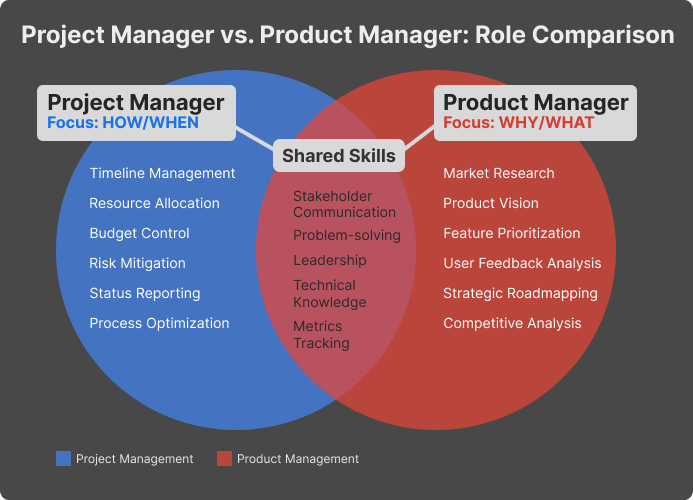When a startup rushed to launch its fitness app, confusion between its Product Manager (PdM) and Project Manager (PM) roles caused chaos: feature changes disrupted sprints, deadlines slipped, and the app launched late to mixed reviews. Only after defining clear responsibilities — PdM shaping what to build, PM driving how and when — did the team deliver a successful update. This scenario underscores a critical need: distinguishing these complementary roles is essential for building efficient, high-performing teams.
The Product Manager defines the right problem to solve; the Project Manager ensures the solution is delivered effectively. Though their responsibilities overlap, their goals and approaches differ fundamentally. This article clarifies these roles, offering insights for career growth, hiring, or team optimization across industries like tech, healthcare, and manufacturing.
Core Responsibilities
Project Manager (PM)
The Project Manager focuses on execution, ensuring projects are completed on time, within budget, and with the right resources. They create detailed timelines, often using tools like Gantt charts in software such as Jira or MS Project, to track progress and dependencies. By identifying and mitigating risks — such as delays or scope creep — they keep projects on track. PMs coordinate cross-functional teams, including developers, designers, and vendors, ensuring alignment and clear communication. Their success hinges on delivering high-quality outcomes within defined constraints, requiring strong organizational skills, expertise in methodologies like Agile or Waterfall, and enough technical knowledge to engage with development teams. Many hold certifications like PMP, PRINCE2, or Scrum Master to sharpen their craft.
Product Manager (PdM)
The Product Manager centers on strategy, defining a product’s vision to meet user needs and market demands. They craft roadmaps, prioritizing features based on business value and customer feedback, often using tools like Aha! or Roadmunk. By analyzing competitors and market trends, PdMs ensure the product remains competitive. They collaborate with sales, marketing, and support teams to achieve market fit, while tracking metrics like user adoption or revenue growth. This role demands deep user empathy, strategic thinking, and data analysis skills, often complemented by domain expertise or certifications like CSPO or Product School.
Examples Across Industries:
- Tech (Mobile App): A PdM adds an AI chatbot to reduce user drop-off (40% abandon the app without quick help). The PM schedules a three-phase delivery in Q3 with a $50K budget.
- Healthcare (Medical Device): A PdM prioritizes FDA-compliant features for a wearable monitor. The PM ensures regulatory testing completes by Q2.
- Manufacturing (Automotive): A PdM defines specs for an electric vehicle battery. The PM coordinates suppliers to meet production deadlines.
Overlaps
Both roles share critical skills, fostering collaboration. They excel in stakeholder communication, aligning executives, developers, and teams through regular updates and expectation-setting, often navigating complex organizational dynamics. Problem-solving is central, as both address obstacles — whether shifting priorities or resource constraints — with agility. They adopt a metrics-driven approach, though PMs focus on launch success and cost control, while PdMs track user adoption and market share. Leadership without direct authority is key, requiring influence and negotiation to drive outcomes. Both roles benefit from understanding customers, with PMs ensuring user requirements are met and PdMs shaping products to delight them. Sufficient technical knowledge ensures credibility with development teams, enabling effective collaboration.
The Venn diagram below illustrates these shared skills alongside distinct responsibilities.

Key Differences
| Aspect | Project Manager | Product Manager |
|---|---|---|
| Primary Goal | Deliver on time/budget | Deliver value to users/market |
| Time Horizon | Fixed (project lifecycle) | Ongoing (product lifecycle) |
| Success Metrics | Deadlines, cost, quality | User adoption, revenue, market share |
| Tools | Jira, MS Project, Trello | Aha!, Roadmunk, Mixpanel |
| Ownership | Process-focused | Vision-focused |
| Risk Management | Tactical (schedule, resources) | Strategic (market, adoption) |
| Reporting | PMO, Operations, CTO | CPO, CEO, business unit |
Example (Software Launch)
| PdM | “Will users value this feature? Does it solve their problem?” |
| PM | “Will QA finish by Friday? Are resources sufficient?” |
How They Collaborate
In Agile teams, the PdM prioritizes the product backlog based on business value, while the PM schedules sprints to deliver selected stories. The PdM clarifies requirements during sprint planning, ensuring alignment with the product vision, while the PM facilitates daily stand-ups to track progress. Both participate in retrospectives, refining the product and process for future iterations.
Conflict Example: A PdM, informed by competitor analysis, requests a new user authentication feature to boost security, but the PM warns it risks delaying the Q3 launch due to limited developer bandwidth. The conflict escalates as the PdM insists on its strategic importance, while the PM cites fixed timelines. They resolve it through a structured negotiation: the PdM presents data showing a 15% user churn risk without the feature, convincing stakeholders. The PM proposes reallocating one developer from a lower-priority task and delays a non-critical feature to the next sprint. Both align on the shared goal of user trust, updating the roadmap and timeline accordingly, ensuring the launch stays on track with the new feature included.
Healthy Dynamic:
- Regular syncs, with PdMs joining stand-ups and PMs attending roadmap planning.
- Clear decision rights (e.g., PdM owns feature prioritization, PM owns timelines).
- Mutual respect for expertise and shared business goals.
Which Role Does Your Team Need?
In startups with fewer than 20 people, PM and PdM roles may overlap due to resource constraints. Mid-size companies separate them as product complexity grows, while large enterprises like Google use specialized roles (e.g., Program Managers). To decide, assess your challenges: struggling with deadlines or costs? A PM excels in execution. Unclear on what to build? A PdM provides direction. In stable markets, PMs ensure efficiency; in evolving markets, PdMs drive innovation.
Career paths often intertwine: PMs may transition to PdM roles, leveraging execution expertise, while PdMs may become PMs, bringing strategic insight. “Technical Product Managers” blend both skill sets. Certifications enhance growth — PMP or Scrum Master for PMs, CSPO or Product School for PdMs — with both benefiting from leadership and technical training.
Conclusion
Project Managers drive “how” and “when,” focusing on disciplined execution, while Product Managers shape “why” and “what,” guiding strategic vision. In smaller teams, roles may blur, but as organizations scale, clear separation prevents confusion and gaps. Together, they deliver valuable products on time and within budget.
AI tools are transforming both roles. PdMs use analytics platforms, like Mixpanel or Pendo, to support data-driven decision-making, with some features potentially enhanced by AI algorithms or machine learning models. Remote work demands virtual collaboration, with tools like Slack and Miro enabling distributed teams to align seamlessly.
Evaluate your team’s needs — execution, strategy, or both? Conduct a team audit using a free PM/PdM role checklist (download at [insert link]). Defining these roles will empower your team to deliver products that delight customers and achieve business success.












